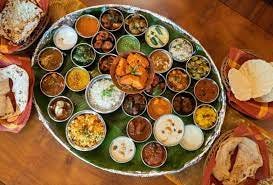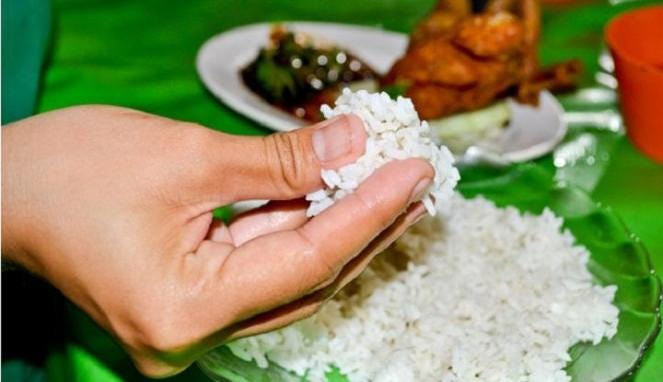The Hands That Feed You: Our Maternal Figures
The Hands That Feed You is our dedication to all maternal figures who have fed, nurtured, and kept our stomachs happy. This Mother's Day, we reminisce on our memories of eating with our hands.
Yellow-stained fingers and the smell of Indian spices clinging onto my fingers long after I’ve completed my meal - these things used to bug me when I was younger.
Why does Indian food have to be so strong? Why does it have to rub off on me like that?
Even though I’ve always loved Indian food, for a long time, I also resisted the cultural practices that revolved around enjoying the food. One example of this is eating with hands. It was usually the indelible “spice stains” on my fingers that made me feel embarrassed or inconvenienced. Looking back, however, my best experiences with Indian food are the meals that I’ve consumed with my bare hands.
One of the best biriyani-eating experiences I’ve had is the time when I travelled to India with my cousins. We visited our extended relatives in Kadayanallur, a little town in Tamil Nadu, and they brought us on an unforgettable cooking experience in a thopu (a plantation).
The women of the household brought charcoal and bricks to build a makeshift stove in the plantation, potable water, enormous earthen pots to cook the biriyani and dalcha. That day, my aunties spent hours by the river cutting and cleaning vegetables.
I vividly remember the texture of the biriyani rice that they cooked. They used a grain fatter than the ones we use in local biriyanis. The food was somehow perfectly warm such that I could eat it immediately. I also remember the unmatched tenderness of the mutton. The mutton was chopped up into smaller pieces and the bones were removed. They were nugget-like in size, hidden like treasures under a fluffy pile of rice. The biriyani was soft and moist with curry but not sticky and wet. I had soaked my biriyani rice with dalcha because that’s the way I like it.
This biriyani was without question, absolutely delicious. The fact that I ate with my hands that day has helped me preserve this particular memory so delicately. The idea is that you engage all your senses when you eat with your hands and so your eating experience becomes fuller and more robust. My thopu biriyani experience is testament to that.
In many ways, Indian food is also made for eating with hands. When eating foods like chappati, thosai or any other Indian bread, you will need to tear the 'bread’. Indian breads are not served in a burrito-like manner, with the curry or side dishes already wrapped into them. Neither are they built for slices like firm and crusty European bread because they are soft and floppy. They don’t really hold up as scoopers. This makes dipping the only option - an exercise you can do best with your hands. Even for the South Indian thali set which consists of 10 or more different side dishes in small metal bowls, making use of cutlery is a little silly. You would need multiple sets of them per person!
Finally, there are also scientific reasons for eating with hands. Research shows that eating with hands promotes mindful eating. The millions of nerve endings on our fingertips are alerted when hands are used in eating. These nerves determine the kind of food being consumed and its nutrition and then send signals to the digestive system to start secreting the relevant digestive juices. This better prepares the body for the eating process. Ayurveda, an ancient Indian medicine system, posits that eating with hands invigorates the food with cosmic energy. This is rooted in the belief that each finger is an augmentation of the five elements - fire, air, space, earth, and water.
When eating with hands, we primarily let our fingers do the heavy lifting. My mother used to tell us “eating properly” meant that the palms of our hands remain clean. This can be tricky, especially when you are eating rice. Only the fingers are used to pick up the different foods with fingers folded in a crane-like manner.
The food is then flattened and shaped into a ball. The thumb is used to push the ball of food into the mouth. Even for soup-like dishes like rasam, it is possible to actually cup your hands very narrowly to drink it from your hands.
This Mother’s Day, Spice Zi Kitchen will be introducing “The Hands That Feed You” menu. This experience is a little different from the usual because guests will be able to cook for their maternal figures and surprise them with a meal at the end. We hope for it to be a meaningful way of showing gratitude for the hands that have tenderly cooked for you, fed you, and nurtured you.
Spice Zi Kitchen is celebrating this Mother’s Day menu in collaboration with Handmade Romantics’ Batik Aprons. At the end of the session, guests will be presented with aprons that are made by traditional Indonesian artisans. These aprons are brightly colored, soft, fitted with pockets, and use traditional batik flower motifs.
‘The Hands That Feed You’ will restart after the current restrictions after 13 June. You may take a look at upcoming classes here.
We are also collaborating with CrazyCat to do a special Our Maternal Figures session - where you will get to learn about and eat Indian Muslim food, and also partake in conversations about the journey with your maternal figure. This will be postponed till further notice due to the current measures. Keep your eyes peeled here.
Happy Mother's Day to all the wonderful mothers, whose hands have shown us love, dedication, and sacrifice. Take care, and stay safe to everyone. These are indeed challenging times for all of us, and as the old adage goes; be kind to one another as you don’t know what the other person is going through.
If you know someone who would be going through something and would be happy to receive a home-cooked meal or anything of that kind, feel free to reach out to us via this newsletter.
This newsletter is written by Vickland Kaamela Barvin, the youngest daughter of Spice Zi Kitchen. She is a self-acclaimed 'almost vegan’ millennial who loves watching Food King videos and endlessly ‘saves’ anything related to food on Instagram, but with the knowledge of making an avocado salad in the kitchen. However, she is a keen and curious editorial assistant to her elder sister, Taahira who proofreads and bites her occasionally.












